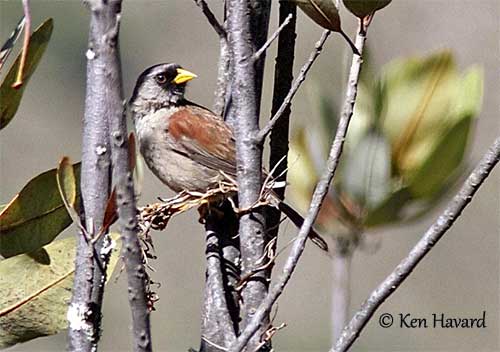
Fr: Chipiu costumé
Ang: Rufous-backed Inca-Finch
All: Schwarzstirnammer
Esp: Incaspiza Dorsirrufo
Esp Perou: Fringilo-Inca de Dorso Rufo
Ita: Fringuello inca dorsorossiccio
Nd: Roodrugincagors
Sd: brunryggig inkafink
Photographers:
Roger Ahlman
Pbase Galleries Peru and Ecuador
Ken Havard
My Bird Gallery & Flickr gallery 1 & Flickr gallery 2
Dubi Shapiro
Dubi Shapiro Photo Galleries
Text by Nicole Bouglouan
Sources:
HANDBOOK OF THE BIRDS OF THE WORLD Vol 16 by Josep del Hoyo- Andrew Elliot-David Christie – Lynx Edicions – ISBN: 9788496553781
BIRDS OF PERU by Thomas S. Schulenberg, Douglas F. Stotz, Daniel F. Lane, John P. O’Neill, Theodore A. Parker III – Princeton University Press 2007– ISBN: 978-0-691-13023-1
BIRDS OF SOUTH AMERICA – Passerines - by Robert S. Ridgely and Guy Tudor – HELM Field Guides – ISBN: 9781408113424
Neotropical Birds – Cornell Lab of Ornithology
LEE’S BIRDWATCHING ADVENTURES PLUS
Home page
Page Passeriforme Order
Rufous-backed Inca-Finch
Incaspiza personata
Passeriformes Order – Thraupidae Family
INTRODUCTION:
The Rufous-backed Inca-Finch has small range in NW Peru in upper Marañón Valley.
It is rather long-tailed with slim, pointed, yellow bill. Back and scapulars are rufous, giving the bird its name. Both scientific and common names refer to the Incan civilization. It is endemic to Peru.
This species is uncommon and local throughout the range, but it occurs at high elevations on W slope of Andes, largely above 3,000 metres.
In spite of being patchily distributed, the population is apparently stable and the Rufous-backed Inca-Finch is not currently threatened.

DESCRIPTION OF THE BIRD:
Biometrics:
Length: 16-18 cm
Weight: 29-33 g
The Rufous-backed Inca-Finch has rufous upperparts including lower back to uppertail-coverts. The upperwing is mainly rufous, but outer median and greater coverts are grey. The tail is black with white outer edges.
On the underparts, lower throat and breast are grey. Belly and vent are white, whereas flanks are buffy-grey.
The head is grey, but slightly browner on the nape. There is a conspicuous black mask around the bill, extending narrowly to forehead and broadly below to chin and throat.
The pointed bill is bright yellow. The eyes are reddish-brown. Legs and feet are orange-yellow.
Male and female are similar.
The juvenile is duller with streaked plumage above and below. There is no black on face and throat. The bill is dull yellow with dark culmen. Legs and feet are dull yellow.

RANGE:
The Rufous-backed Inca-Finch occurs on both slopes of upper Marañón Valley (in S Cajamarca, E La Libertad, NE Ancash and W Huánuco) in NW Peru.
HABITAT:
The Rufous-backed Inca-Finch is uncommon and local in arid montane scrub. It frequents the dry slopes with cacti and agaves. It can be seen between 2,700 and 4,000 metres of elevation.
CALLS AND SONGS: SOUNDS BY XENO-CANTO
The song of the Rufous-backed Inca-Finch is a simple, repeated “tic sweee-eee?”
The call is a high “tsee”.

BEHAVIOUR IN THE WILD:
The Rufous-backed Inca-Finch feeds on fruits of cacti and probably takes seeds too.
It is mainly terrestrial and forages on the ground by hopping among the dense vegetation.
It can be seen alone or in pairs. They often rest in shade within cover.
The breeding behaviour is unknown.
The Inca-Finches of genus Incaspiza commonly perch on top of tall cacti or in small trees when singing.
They can be seen in small groups outside the breeding season, but they do not join mixed-species flocks.
The Rufous-backed Inca-Finch is sedentary. It only performs short flights while foraging.

REPRODUCTION OF THIS SPECIES:
From some observations, males in breeding conditions were found between late March and June. Some fledglings were seen in May.
These birds are usually monogamous. Only females develop an incubation patch and incubate the eggs. The male is territorial and performs mate-guarding during the laying period.
The incubation ranges between 12 and 15 days. The young are fed by both parents.
PROTECTION / THREATS / STATUS:
The Rufous-backed Inca-Finch has restricted range in which it is uncommon and patchily distributed.
The population is suspected to be stable and not globally threatened.
The Rufous-backed Inca-Finch is currently evaluated as Least Concern.
